- Bernard Preston homepage
- Hummus
- Cooking Chickpeas
Cooking chickpeas
Cooking chickpeas is simple but some aforethought is necessary. That is why we keep frozen packets in the freezer.
These are the most convenient legumes to my way of thinking; the majority of people in the whole world agree that they are the best source of protein.
Or at least they are the most commonly eaten; a prime fillet steak is probably relished more highly.
In a Western World which overindulges in red meat, with all the attendant consequences we can learn a few lessons from the underdeveloped countries.
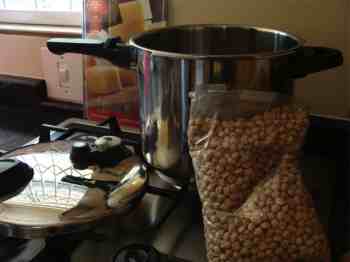
This page was last updated by Bernard Preston on 9th April, 2024.
Protein
One cup of the cooked legume contains about a quarter of your daily protein requirement.
The fibre is particularly valuable to the colon, making the stool soft and easy to pass; less bowel tumours, polyps and piles. Just as important it has been proven to lower cholesterol. Diabetics who eat only one-third of a cup per day have far better control of their blood sugar.
Face up to the controversies surrounding legumes though. There are groups recommending you avoid them completely either because of their anti-nutrient or starch content. Eventually scientists will largely come into agreement but for the moment many winds swirl about.
We enjoy them without hesitation but do follow some important protocols.
Prevention
So it comes as no surprise that international heart, diabetic and
neoplastic associations all recommend consuming chickpeas on a regular basis.
Personally, I make hummus twice a week and eat this
delicious food daily with a green salad.
Chickpeas, roasted garbanzo beans and falafel burgers are great favourites in many parts; and the soup is to die for.
For your recipes do not buy them in cans. Cooking chickpeas is so easy; and you run no risk of botulism or contamination from the lining of the tin. And you can be certain they have been properly soaked and rinsed.
3 possible levels of preparation
1: Soak, rinse and boil
The most time-consuming part of the preparation of cooking chickpeas is to soak them for at least 12 hours, tossing in a few slices of fresh lemon (or vinegar) to acidify the liquid. Rinse and drain once or twice to remove most of the dissolved antinutrients.
Pressure-cook for 25 minutes; the liquid fraction is then drained off and may be used as aquafaba.
In fact many gurus, less anxious about these anti-nutrients, say that incorporating the cooking liquid gives the dish far more flavour.
They have a point; vegetarians who eat mostly food rich in anti-nutrients are no more prone to osteoporosis and anaemia than omnivores. They get plenty of calcium and iron from their food.
2: Soak, rinse and sprout
Soak and rinse the chickpeas as in Level 1.
Place the soaked legumes in a large bottle and cover with a cloth; secure with a strong rubber-band.
Invert the bottle so that excess water can drain out; rinse daily. Within a few days they will begin to sprout.
Place in a pressure-cooker together with a few slices of lemon, cover with boiling water and heat for twenty minutes.
3: Soak, sprout and boil; and then ferment
After level 2 mash the cooked chickpeas, return them to the bottle and add a tablespoon of kefir culture per cup of legumes. Seal the bottle with a lid and allow them to ferment for a couple days.
Open the lid daily to release the gas that will build up.
Freeze the fermented, mashed chickpeas in cup-sized tubs. We use it mainly in our authentic hummus recipe and to lower the glycemic index of our artisan bread. You will find other ways; perhaps making falafel regularly or as a thickener in soups and stews.
Synergy of green living
There's a synergy of green living that develops slowly over time. Once you get into solar power, you find it enables harvesting rainwater. When you start cooking chickpeas you discover that the kefir benefits that you have already learned will help with fermenting them in a way that is better than just soaking and rinsing.
It is a fun way of living. Suddenly you no longer need those calcium supplements, and constipation is no longer a problem as your colon starts to behave the way it should. Ultimately, in the years ahead, research reveals that means less disability from osteoporosis and a lessened likelihood of the nasty neurodegenerative conditions like Parkinson's disease.
Cooking chickpeas
Your dried chickpeas are dirt cheap; around 2 dollars per kilogram in South Africa, but half of that in Holland with its big Turkish community. You may have to shop around. Ask folk from the Mediterranean lands or the East where they can be purchased.
I have no inside information about whether they are mostly genetically modified or not. Gradually I'm moving to the non-GM camp, if only because of the Roundup residues found in our food.
Accept though that GM foods will be cheaper; they don't need to be weeded. Gardeners get around this by mulching, but it is difficult on a large scale for farmers.
You will need to soak your garbanzo beans at least overnight in water, and preferably longer to start them sprouting. They have a growth inhibitor so do not pour the liquid onto your potted plants. Dump it on the lawn; less grass to mow.
Legumes contain anti-nutrients like lectins and phytates which certainly inhibit the absorption of minerals and allegedly may cause leaky gut syndrome, so a long soak, with a rinsing or three, to remove these substances makes sense.
You can soak them for perhaps 36 hours, but then you need to replace the water frequently to dissolve the lectins and phytates; at least a couple times a day.
The longer the soaking period, the shorter the boiling time, but never less than twenty minutes in a pressure-cooker.
Garbanzo beans
In case there is some confusion about cooking chickpeas, they are also known as garbanzo beans. They are my favourite legume though each has its virtues.
Broad beans for example have the highest percentage of vegetable protein, a whopping 25%, and a very important phytochemical called L-Dopa; it is required by cells in the Substantia Niagra in the brain and others in the colon to synthesise dopamine to prevent Parkinson's disease.
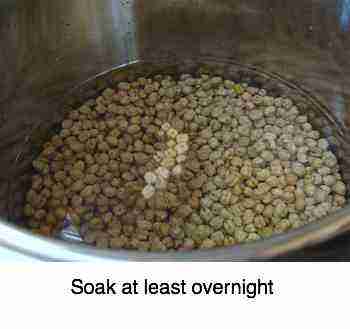
These garbanzo beans aren't covered with enough water; they explode by imbibing large amounts. During the whole of the soaking period they should be covered.
See these are high and dry. More is needed; you cannot add too much. Then, rinse thoroughly with fresh water.
Soaking and rinsing helps to deal with the phytic acid that inhibits the absorption of some important minerals.
Pressure-cooker
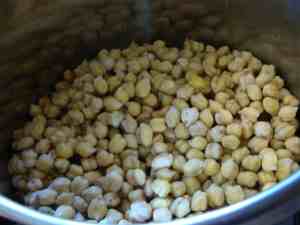
A high quality, safe pressure cooker is a must for every family. It is such a time-saver and, if you are one of those odd green creatures, a huge reduction in energy consumption.
If you want to make garbanzo bean recipes regularly, and you should, then you need a plentiful supply of cooked chickpeas; we will use the terms interchangeably. Preparing them on the stove takes at least an hour and a half; less, and they'll give you a belly ache.
But just thirty-minutes in your cooker, leave them to stand until the pressure has dropped and, hey presto, your chickpeas are ready for use.
There is only one criterion for your pressure-cooker; stainless steel, not aluminium. Spend the extra, rather than risk the possible association with Alzheimer's.
Buying them online incidentally is often cheaper, even after delivery costs. I've just purchased one for a gift for a friend and it was significantly less. More about solar pressure-cooking.
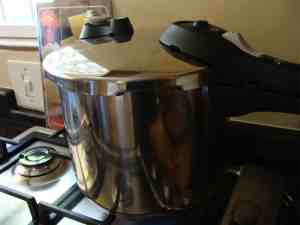
Bring to pressure for fifteen-minutes, turn off and wait for it to normalise; it will sometimes take half an hour. Rinse several times and allow them to dry in a colander for a few minutes.
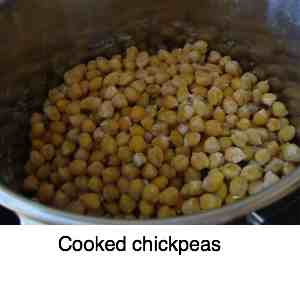
Put them into cup-sized packets and freeze immediately.
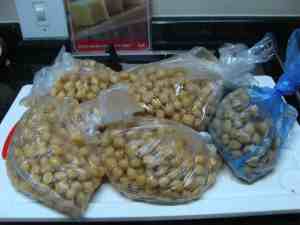
Of course keep back one cup; perhaps my authentic hummus recipe. Enjoy with a mixed salad for lunch.
Enjoy as wide a mix of salads as you can find. Avocado benefits for your nerve coating, tomato prostate for you know what, and green peas just because they are so delic; you don't even have to pod these sugar snaps.
Lettuce is perfect for high folate levels; that's a most vital B vitamin. Drizzle with extra virgin olive oil and a squeeze of fresh lemon; and just a tiny bit of honeycomb on the side, only for the very privileged.
Just add a slice of whole wheat bread and butter and your favourite spread, perhaps cheese or some guava jelly, and you have the complete nutritious meal.
No margarine you'll note; it is not necessary for those who enjoy a lunch like this and research proves conclusively there is no point changing from butter.
See the good dollop of hummus? It takes me only four minutes to make it once I've been cooking chickpeas.
Choline
Choline is an "essential" nutrient so important that it really should be included in the B vitamin family; if deficient toxic homocysteine builds up causing fatty liver disease and inflammation of the blood vessels.
"Betaine, a choline derivative, is important because of its role in the donation of methyl groups to homocysteine to form methionine."
- The Journal of Nutrition[7]
1 cup of chickpeas contains about 15% of the dietary requirement. Ninety percent of people eating a typical grocery store food are deficient in choline. In fact most legumes have significant amounts of this important precursor of betaine.
Every family should be cooking chickpeas and enjoying a helping daily. It's that important.
Advanced Glycation End-products
Advanced Glycation End-products (AGEs) are formed by cooking foods with dry, high heat, as in grilling meat. They produce the highly reactive oxygen species (ROS) that contribute significantly to diabetes and cardiovascular diseases.
AGEs are significantly reduced when cooking with moist heat, at lower temperatures, and in acidic conditions by adding lemon juice or vinegar. This is the perfect way for preparing chickpeas.
Another chief cause of the formation of AGEs is chronically raised glucose levels. Chickpeas have a low glycemic index and will not cause a spike in blood sugars. It is refined starches that are the devil; by raising triglycerides, not from ingested fat, but chronic excess carbohydrate consumption (CECC), as it is called, they are very destructive of the beta-cells in the pancreas.
Aquafaba
Aquafaba is the mucinous liquid left after cooking legumes such as chickpeas. In the past it was discarded but it now known to contain some protein and chains of sugars that join together to form compounds called saponins.
These saponins give aquafaba its foaming properties. It can be used to replace egg whites in cooking treats like meringues.
A project for the future is to use it as a thickener instead of corn-starch.
Newsletter
Our newsletter is entitled "create a cyan zone" at your home, preserving both yourself and Mother Earth for future generations; and the family too, of course. We promise not to spam you with daily emails promoting various products. You may get an occasional nudge to buy one of my books.
Here are the back issues.
- Lifestyle and ideal body weight
- What are ultra-processed foods?
- Investing in long-term health
- Diseases from plastic exposure
- Intensive lifestyle management for obesity has limited value
- A world largely devoid of Parkinson's Disease
- The impact of friendly bacteria in the tum on the prevention of cancer
- There's a hole in the bucket
- Everyone is talking about weight loss drugs
- Pull the sweet tooth
- If you suffer from heartburn plant a susu
- Refined maize meal and stunting
- Should agriculture and industry get priority for water and electricity?
- Nature is calling
- Mill your own flour
- Bake your own sourdough bread
- Microplastics from our water
- Alternative types of water storage
- Wear your clothes out
- Comfort foods
- Create a bee-friendly environment
- Go to bed slightly hungry
- Keep bees
- Blue zone folk are religious
- Reduce plastic waste
- Family is important
- What can go in compost?
- Grow broad beans for longevity
- Harvest and store sunshine
- Blue zone exercise
- Harvest and store your rainwater
- Create a cyan zone at your home
Authentic hummus recipe
After cooking chickpeas, and freezing them, but check out our famous authentic hummus recipe; after making it twice a week for ten years, I think I can speak with some authority on the subject.
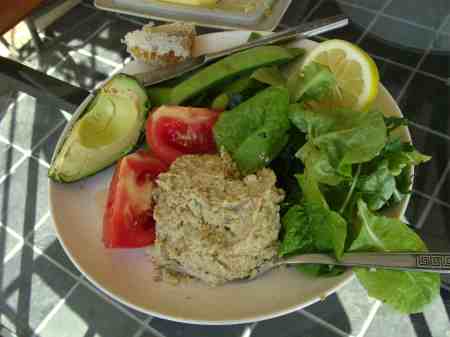
Falafel burgers
If you are into fast food, but you are really trying to reduce your red meat consumption, then try these falafel chickpea burgers.
It is also spelled felafel. Or, just mix a little blended cooked chickpeas into your ground beef.
Soya bean burgers are not very exciting, but made with chickpeas, also known as falafel in the Middle East, vegetarian food can be highly nutritious, have zero cholesterol and be very tasty.
Soyas have a very high anti-trypsin content; they are require special treatment which, if not done, makes them indigestible, giving us a bellyache. I avoid them, in part because the Amazon jungle is being chopped down to plant them in a world demanding more vegetable protein.
Lentils
Lentils are a first cousin to chickpeas; both are legumes of great value. The best of the former is perhaps that they don't need pressure-cooking and can be prepared in a much shorter time.
Consider the best way to cook lentils, for example.
Weight loss research confirms the benefit of consuming both lentils and chickpeas regularly; though if you are overweight do limit the glycemic-load. Have smaller portions.
The ketogenic diets are controversial but they certainly do have certain benefits like controlling hunger-pangs; they give satiety.
We do not advocate any diets; none of them work because they are not sustainable. Could you give up bread and chickpeas for ever because of their starch content? Clearly the answer is no; neither should you. Learn rather how to prepare them correctly.
When there are carbs galore from the garden then we tend to eat smaller portions of legumes, bread and maizemeal porridge[2]. Keep daily starches well below 150g and much less if you are diabetic. Enjoy what's in season.
Choice foods
It can now be stated without fear of contradiction that too much red meat, and in particular if it is processed and charred, is a major cause of tumours. Prime on my list of choice foods is cooking chickpeas.
If you're eating red meat more than two to three times a week, give serious consideration to moving towards more legumes like cooking chickpeas and broad beans; and lentils too; avoid buying them in a can.
That's if you want to sit under those trees you once planted and watch the grandchildren grow up.
You will probably never grow tired of chickpeas, but learning the best way to cook lentils is not a bad thing; even simpler.
Chickpea or Chicken broccoli recipe
Broccoli makes one of the most nutritious anti-tumour soups. Enjoy it with nourishing protein food.
Chicken broccoli recipe with the option of chickpeas; it is also anti-inflammatory.
When browsing use right click and "Open Link in New Tab" or you may get a bad gateway signal.
What is the best way to cook chickpeas?
What is the best way to cook chickpeas? You now know the answer of course; under pressure for 25 minutes. In an ordinary pot the liquid boils over and makes an awful mess.
Do chickpeas need to be soaked before cooking?
Do chickpeas need to be soaked before cooking? Yes, like most other dried legumes they certainly do; preferably overnight. It also removes the so-called antinutrients.
Should you cook canned chickpeas?
It's not necessary to cook canned chickpeas but it would do no harm. In fact boiling them for a few minutes and then draining would remove the excessive salt and preservatives that manufacturers often add.
Did you find this page interesting? How about forwarding it to a friendly book or food junkie? Better still, a social media tick would help.
- Bernard Preston homepage
- Hummus
- Cooking Chickpeas
Address:
56 Groenekloof Rd,
Hilton, KZN
South Africa
Website:
https://www.bernard-preston.com